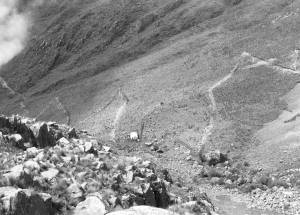Hoping to one day fill a void left by major companies, Peru-focused Strait Gold (SRD-V, SAIDF-O) has grown from one to four early-stage projects since going public in fall 2006.
The company’s president and CEO, Jim Borland, says there is often a gap in exploration spending when larger companies merge and this is contributing to a lack of new discoveries.
“Their combined exploration budgets are often lower,” Borland said at the company’s annual general meeting in May. “There’s a need for companies like us.”
The next few months mark the company’s second exploration season — Strait Gold isn’t able to explore during the Peruvian summer.
One of the new properties, Letra Rumi South, a copper porphyry target, will be the focus of a 1,500- metre drill program this season.
The 9-sq.-km project has also shown evidence of gold, silver and molybdenum, and is located next to the company’s Culebrilla gold property.
Vice-president exploration Ryan Weston says the property shows potential for bulk-tonnage copper, with mineralization detected to 100-200 metres depth.
Three strong induced-polarization (IP) anomalies coincided with surface gossan zones — rustcoloured capping or staining that signals oxidation or alteration of iron sulphides. So far, 182 samples were collected from two of the gossans, averaging 0.1% copper, reaching as high as 4.4% copper, 2.5 grams gold per tonne and 77.4 grams silver.
The company will drill five or six holes to depths of 200-300 metres.
“If we get encouraging results, we’ll continue,” Borland says.
Strait Gold will also continue with sampling, mapping and geophysics and setting up drill permits at its other properties.
San Jorge is an epithermal silver-gold project where Weston sampled nearly a dozen veins during a one-day visit last July.
“I sampled eleven veins but there are more there,” Weston says. “All came back anomalous.”
Chip samples ran up to 428 grams silver per tonne with 1.5 grams gold across 1.4 metres.
The other newer project is the Pallcamachay copper-gold-molybdenum porphyry project, where the company plans to do first-phase mapping, sampling and IP geophysics soon.
Strait Gold will continue to examine Culebrilla, a gold-silver property that saw drilling last year.
Only four of 11 known zones were tested in 2007, so Borland says there’s more to check out.
Last year’s 2,000-metre drill program was cut short after 1,300 metres of drilling due to the rainy season. Results showed weakly anomalous to low-grade gold-silver mineralization and it was determined that the surface veins were generally discontinuous or poorly mineralized in the subsurface environment.
The company has $1.8 million in the bank, which it expects will see it through three drill programs.
Strait Gold shares recently traded at 13 apiece and the company has 23 million shares outstanding.


Be the first to comment on "Strait Gold expands grassroots exploration in Peru (June 02, 2008)"